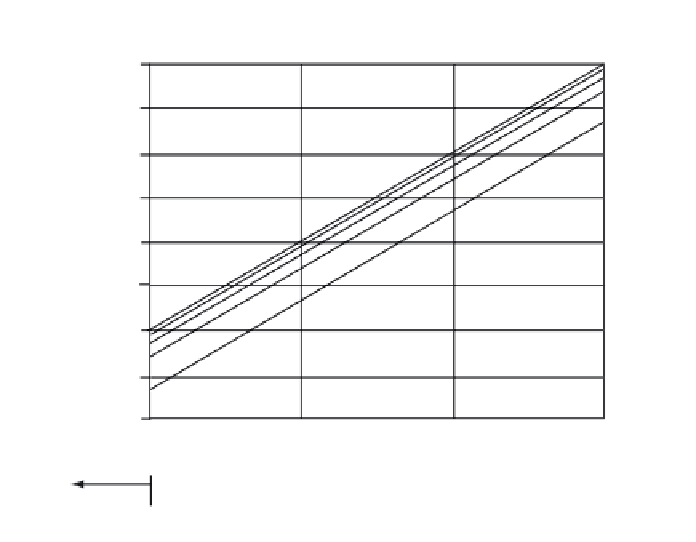Geoscience Reference
In-Depth Information
Upper limit of
Stokes's Law
100
10
m month
−
1
26,000
1
0.1
2,600
Turbulent
flow
0.01
260
Laminar flow
3.0
0.001
26
2.5
2.0
1.5
0.0001
2.6
1.1
Particle density (g cm
−
3
)
0.00001
0.26
Fig. 4.13
The relationship
between the settling velocity
(
v
; of spherical particles) in
water, particle diameter and
particle density (at 20°C) as
given by Stokes' law.
0.000001
0.0001 0.001 0.01 0.1
Particle diameter
Cohesive materials
Suspended materials
(Brownian motion)
Friction materials
the sense that it may not be deposited in the lake.
In many lakes (see Håkanson & Jansson 1983),
Cl, Ca and alkalinity are typically conservative
substances, and colour, organic matter, total P,
Si, particulate P and suspended matter are more
reactive.
The particulate fraction and the colloidal
fraction may be subject to mineralization by
bacterioplankton. Traditionally (see Santschi
& Honeyman 1991; Gustafsson & Gschwend
1997), the
K
d
concept is used in these contexts;
K
d
is the ratio between the particulate (
C
′
par
in g
kg
−1
dw) and the dissolved (
C
diss
in g L
−1
) phases,
i.e.
K
d
=
4.2.4.1 The distribution coefficient
′
par
/
C
diss
. The
K
d
ratio is often given
in L kg
−1
. This means that the dissolved fraction
(
D
diss
) can be written as:
C
A very important part of most mass-balance
models for chemical substances is the distribu-
tion coefficient. The lake distribution coefficient
is also often called the partition or partitioning
coefficient and gives the particulate fraction (
PF
)
or the dissolved fraction (
DF
K
d
· SPM · 10
−6
)
D
diss
=
1/(1
+
where SPM is the amount of suspended matter
in the lake water (in mg L
−1
). It is essential to
distinguish between the dissolved and the par-
ticulate fractions for all substances. It is espe-
cially important to do so for the key nutrient in
lake management, phosphorus, because phyto-
plankton takes up dissolved P and only particulate
P can settle out. This means that there are differ-
ent transport routes for the two fractions. The
concentration of suspended particulate matter
(SPM) influences the distribution of phosphorus
into these two fractions. The settling velocity
for particulate P in (m yr
−1
) may be turned into a
PF
). Related
to sedimentological processes, there are three
major categories of matter in lake water:
1
the particulate fraction (PF), which is the only
fraction settling by gravitation;
2
the dissolved fraction, which is the most im-
portant one for direct biouptake by, for example,
phyto- or zooplankton and often referred to as
the bioavailable fraction;
3
the colloidal fraction, which is neither subject
to direct uptake nor to sedimentation because
the particles are too small.
=
1
−









